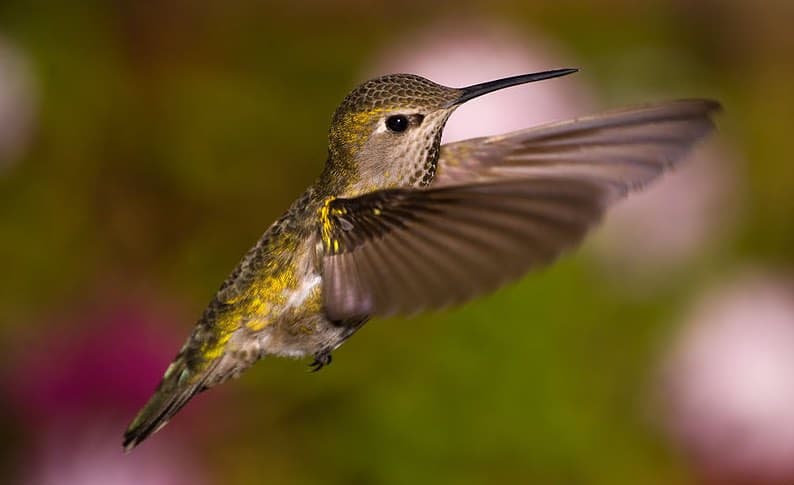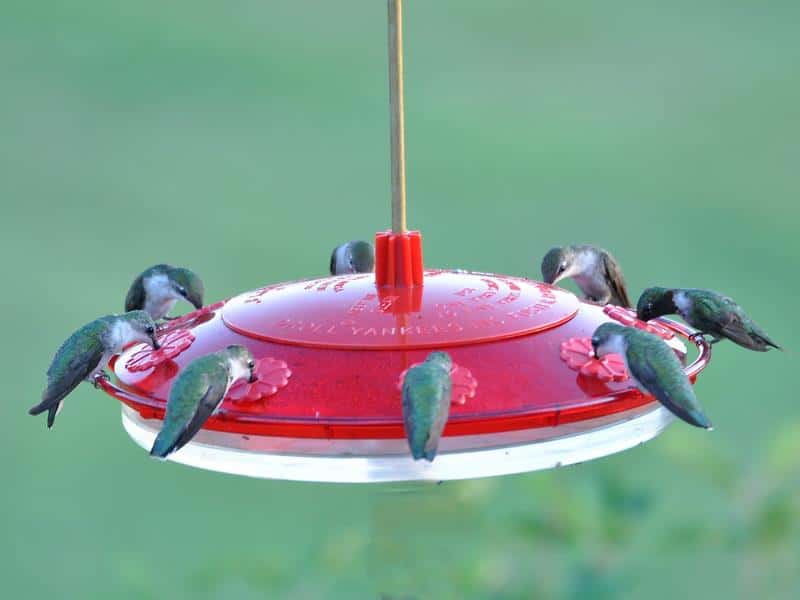Article Topics
- The Avian Nectar Feeders
- True Nectar Feeders
- Bill Shape
- Foraging Efficiency
- Flexible Bills
- Feeding Sugar Solutions
- Readers’ Observations
The Avian Nectar Feeders
When the words “nectar feeder” come to mind, most people envision hummingbirds gracefully flitting around flowers in a bed or on a shrub. But that is not the whole story. In various parts of the world one can find other kinds of birds that enjoy a sip of nectar or a sweet sugary solution, depending on how accessible it is.
Not all of the true nectar feeders can hover like the hummingbirds; the Old World sunbirds, the honeyeaters of the southwestern Pacific region, some of the many Hawaiian honeycreepers, tropical honeycreepers, and tanagers and orioles instead cling to flowers to take nectar.
In North America, more than 60 songbird species appear to have a “sweet tooth.” Even some parrot species, like lorikeets, readily sip sugar solution from a dish held in one’s hand; various zoos offer this opportunity to visitors. Not only North American songbirds crave sweet solutions; in Australia, wild common silvereyes and noisy miners also feed on nectar from natural sources.
The “insatiable” house finches are among the common nonhummer guests that readily sip sugary solutions offered in hummingbird feeders. They can be a nuisance, monopolizing a feeder. However, the late Sally Spofford, once renowned for her fantastic backyard catering to hummingbirds and orioles in Portal, Arizona, documented a wide variety of species visiting her sugar feeders.
A partial list compiled in 1977 includes grosbeaks, various woodpeckers, sapsuckers and flickers, jays, chickadees, wrens, catbirds, several warbler species such as painted redstart and black-throated blue, clay-colored robins, and goldfinches.
Because many countries, particularly in Europe, do not have hummingbirds, honeyeaters, sunbirds, or other similar species, people who feed birds do not bother to put out feeders containing sugar solutions. If they did, we’d likely see the list of sweet-loving birds lengthen considerably.
True Nectar Feeders
Margaret Rubega of the University of Connecticut says that “hummingbirds are a textbook case of coevolution.” Not only have the true nectar feeders adapted themselves to a lifestyle of taking nectar from flowers, but the flowers themselves have evolved to make this easier for the birds.
It is in the best interest of the flower to facilitate the removal of its nectar, because at the same time, birds and bees also remove the plant’s pollen and deposit it in other flowers, all in the name of fertilization.
Bill Shape
Besides the ability to hover, the other single-most important difference between the true nectar feeders and the pretenders is the bill shape. Most bird species simply do not have the proper bill shape to efficiently remove nectar from flowers. Hummingbirds and sunbirds, however, are well adapted to do this.
They stick their long, thin bills into the floral nectar chambers and suck up the sweet juice through tubed tongue tips. And the forms of their bills tend to match the lengths and curvatures of the flowers they prefer. The very long, decurved bill (about 2 1/2 inches) of the magnificent hummingbird correlates nicely with the long, curved corollas of the flowers it seeks out, and the short straight bill (about a half inch) of the volcano hummingbird matches its preferred flowers as well.
Sometimes, though, these hummers must feed from flowers of other sizes and shapes, and this can have consequences on the efficiency of foraging behavior.
Foraging Efficiency
A good example of this is seen in a classic study by Frank Gill and Larry Wolf on three sunbird species found in East Africa. All three species feed on a certain mint plant, but their bills vary in length, the longest in the malachite and the shortest in the variable.
The bill of the golden-winged sunbird is just slightly shorter than the malachite sunbird, but it is able to remove 90 percent of the nectar in the shortest visit time per flower (1.3 seconds). The golden-winged’s strongly curved bill better matches the curvature of the mint flower.
The malachite forces its straighter bill down into the curved corolla but has to make several jabbing, time-consuming motions to do so-1.8 seconds per visit. It can obtain about 80 percent of the nectar on average, but sometimes it misses the opening of the diaphragm into the nectar chamber altogether and neither nectar nor pollen is transferred.
The variable sunbird, with its fairly short bill and tongue, cannot even reach down into the corolla and instead cleverly stabs the base of the flower to gain access to the nectar chamber. This strategy, though, takes 2.8 seconds per flower and allows the bird to remove barely 60 percent of the nectar and none of the pollen.
When we offer sugar solution to hummingbirds in our feeders, most of the designs (but not all) offer access to other kinds of songbirds that do not possess these uniquely adapted bills. If the feeder design does allow for easy access for woodpeckers or grosbeaks, then efficiency does not come into play. And that is why house finches can sit all day, or until the sugar solution runs out, on a hummingbird feeder.
Flexible Bills
Just like the finches, hummingbirds are also variable with in their menu. Although nectar is a great energy source, it lacks many important nutrients, especially amino acids. So hummingbirds derive virtually all of their protein from insects. In fact, spiders are an important item in their diet. However, those long, skinny bills would not seem to be exactly ideal for insect catching.
So how do hummingbirds acquire insects? Well, their bills are also adapted in another manner-they bend. Three years ago, Margaret Rubega and colleagues used high-speed video to observe that hummingbirds can bend their lower bill downward by up to 20 degrees. This opens the bill wider and enhances the bird’s ability to catch an insect in its mouth rather than on the tip of its bill.
The birds even flex their lower jaw laterally to widen their gape so as to make it easier to trap insects. Even more surprising was the finding that hummingbirds do not have a joint in their lower bill to facilitate the bending. Some fly-catching birds have a joint to allow them to flex their lower jaw laterally to make it wider, but none have the ability to flex their bills in two dimensions like hummingbirds.
How did hummingbirds evolve then? The oldest hummingbird fossils (30 million years old) were discovered in Germany three years ago, even though hummingbirds no longer exist in the Old World. In the paper published in a May 2004 issue of Science, scientists speculated that they may have gone extinct due to either climate change or competition with other nectar-feeding birds (or perhaps both).
Rubega believes that hummingbirds and swifts evolved from a common ancestor that was insectivorous. Although the swifts remained insectivorous, the hummers switched over to nectar, but not entirely, largely reducing the competition.
Feeding Sugar Solutions
In response to concerned folks who worry that leaving their feeders up in the late fall will cause the hummingbirds to forgo migration, most books on bird feeding will advise you that maintaining your feeders will only serve to help out any stragglers encountering seasonal food shortages.
One also hears suggestions that instead of the usual 4:1 (water to white sugar) dilution rate, ratios of 5:1 and even 7:1 might be better for the birds. There are some new twists on these recommendations and they have to do with the increase of metabolic rate due to nectar dilution and food-warming costs.
When endothermic organisms take food into their bodies, they must warm it up to body temperature, an energy-demanding process. As one might expect, nectar-feeding birds take in a fair bit of water. In fact, this can be anywhere from roughly 1 to 8.5 times their body weight. In a study of rufous hummingbirds, Chris Lotz of the University of Wyoming in Laramie and colleagues discovered that these tiny creatures “pay a high cost for a warm drink” (the title of their paper in the June 2003 issue of the Journal of Comparative Physiology B).
They basically argue that there is a significant energetic cost to hummingbirds to warm that large quantity of nectar to body temperature. In a later study of collared sunbirds, they further found that when nectar is dilute, nectar-feeding birds must ingest even larger volumes to compensate for its lower caloric value.
To take in more nectar volume, the birds will incur even higher energetic costs because they must increase their foraging activity and/or they must warm up all that ingested nectar. Nectar already prewarmed in flowers might explain why there are so many more hummingbirds in semidesert regions compared with cooler places.
Here is my take-home point from these studies. Offering sugar solutions in the cool temperatures of late fall to straggling hummingbirds is not totally beneficial to them if they have to incur higher energetic costs to warm it to body temperature. On the other hand, if the sugar solution is kept a little “sweeter” at these times, the benefits to the hummingbirds might be more substantial.
Thus, suggestions of a more dilute solution to 5:1 or 7:1 might be a little bit premature. I am not suggesting that you heat up your liquid offerings before serving, but merely ensure that the solution is not too diluted. In any case, a hummer feeding at a bottle, especially one with a perch, certainly does not have to incur any serious energetic costs by hovering.
Readers’ Observations
In the past, I have had sent to me by e-mail two amazing photographs involving hummingbirds. One depicts a rufous hummingbird hovering in front of a row of holes apparently drilled by a yellow-bellied sapsucker. The second, which was sent to me by several folks, shows a woman holding a small dish of what is likely artificial sugar solution in her hand with several immature ruby-throated hummingbirds hovering around and even sipping from the dish.
Comments: It would too easy to conclude that the hummingbird hovering in front of those sapsucker holes was actually interested in the sap. As pointed out, hummers derive much of their protein by eating insects and it is my educated guess that the hummingbird is more attracted to any insects stuck in the flowing sap.
It is well known that sapsuckers drill those rows of holes with the intention of revisiting them later to take in both the sap and any insects trapped therein. I cannot prove it at this time, but I would wager that hummers might find that sap to be a tad viscous. If anyone can shed light on this, I welcome their comments.
As for the woman hand-feeding the hummers, this does not surprise me in the least. Several bird species including black-capped chickadees (and I suspect other chickadee species), nuthatches, and blue jays can be induced, with much patience, to take seeds from one’s hand.
Hummingbirds are also well known for their occasional habit of hovering right in front of a human’s face if they are sporting some red-colored item. I am assuming that most, if not all, of the hummers in that picture are juveniles or young-of-the-year. Young birds are more naive and less frightened in the presence of “potentially predatory” creatures. Looks like loads of fun!




